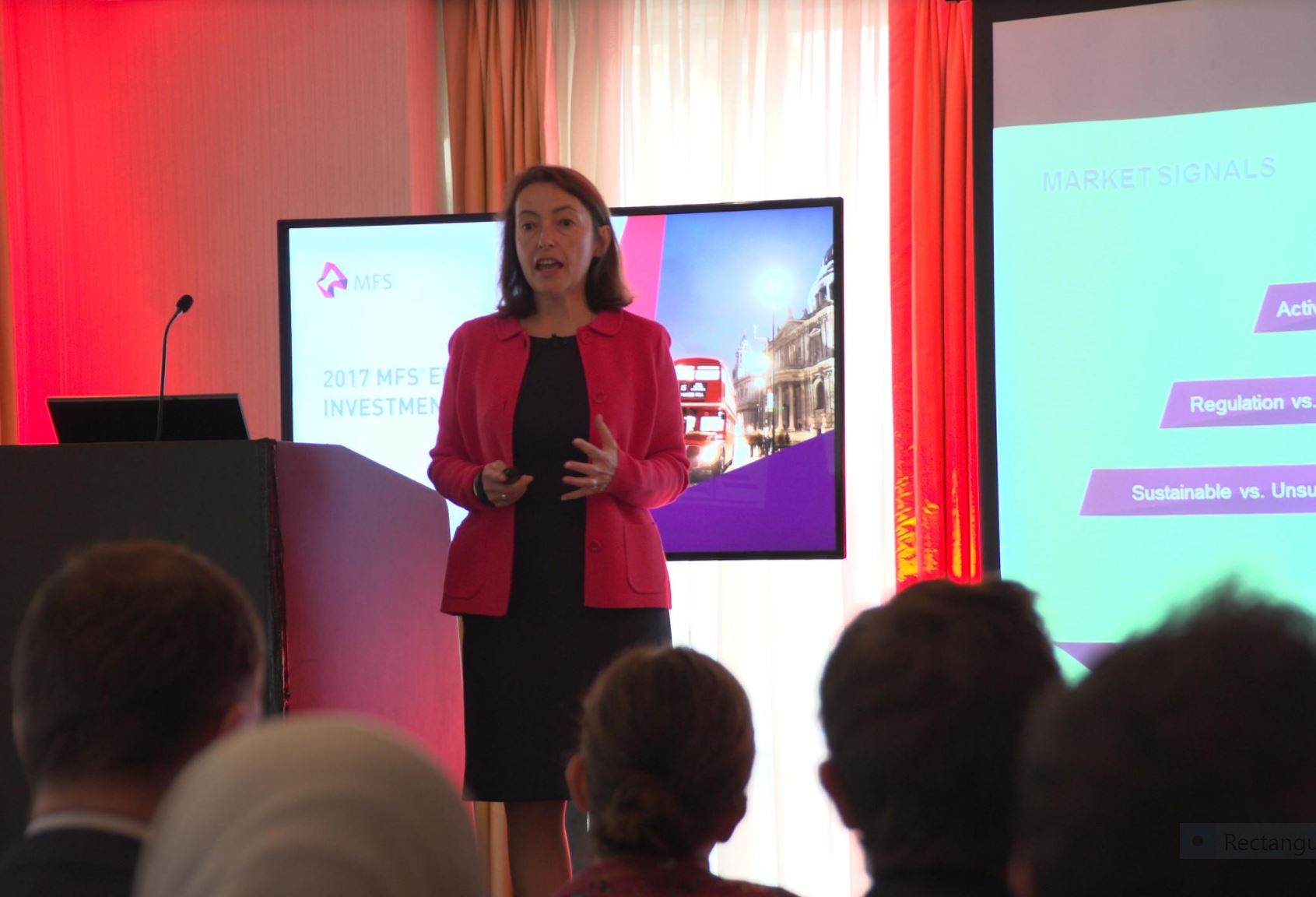Michael Roberge: “If Berkshire Hathaway Were a Mutual Fund, Warren Buffet Would Have Been Fired as a Manager”
| Por Meritxell Sedo | 0 Comentarios
Investors are at a crossroad. To be able to obtain the same level of returns as in the past and achieve their investment goals, they must take on roughly three times more risk than that of two decades ago. During the 2017 MFS European Investment Forum in London, Michael Roberge, CEO, President, and CIO of MFS Investments Management, emphasized the secular and cyclical difficulties facing investors and the importance of choosing active managers who are both committed to investing with a long-term time horizon and have conviction in their portfolios.
Secular challenges
Following the Global Financial Crisis, the prolonged approach of central banks around the world was to try to stabilize the economy by keeping rates low. This approach has resulted in extremely low interest rates persisting, with some countries even dipping into negative yields. These low interest rate levels have completely changed the investment environment, helping to push both bonds and stocks to maximum valuation records. Many investors, including MFS are asking what will this environment lead to? While asset prices are expensive today, the lower-for-longer rate environment is likely to dampen returns for both equity and stock investors in future business cycles. With that backdrop, investors will be challenged to achieve their investment goals and we can expect to see many investors taking on greater risk to achieve the same historical return they would expect to achieve in a more normal environment. To illustrate the case, Michael Roberge mentioned a study by investment services consulting firm Callan Associates. The report shows that in 1995, in order to obtain an average return of 7.5% — which is the average yield that most pension plans expect to obtain in the long run – an investor would need to allocate approximately 73% to bonds and 27% to cash. The volatility of the portfolio, measured by its standard deviation, was around 6%, so that the investor was not really exposed to excess risk. In the following decade, the deterioration of interest rates has meant that, to achieve the same return of 7.5%, new asset classes must be introduced. Investors have to expand the allocation beyond the fixed income and cash instruments, needing instead to add riskier exposure to equities and alternative assets, for example. The new portfolio would now need to invest 52% in fixed income, 40% in equities and 9% in alternative assets, including exposure to private equity and real estate. This results in a more complex portfolio which incurs greater risk, with a volatility of 8.9%, representing a 50% increase relative to the portfolio of the previous decade. Moving forward another 10 years, in 2015, following the Global Financial Crisis and a dramatic drop in interest rates, central banks significantly increased their balance sheets with quantitative easing measures. To achieve the same return of 7.5%, the portfolio now would need to invest 12% in fixed income, 63% in equities, and 25% in non-traditional assets. Given the complexity of this portfolio, the risk rises up to 17.2%, tripling the risk level of 20 years ago. «This explains the current stress of investors globally, because they can see the potential for lower future returns as compared to those currently and in the past. Of course, they still have to meet their investment goals. The problem now is that they have to take greater risks to achieve them,» said Roberge.
Cyclical challenges
While the United States is experiencing its second longest economic cycle since World War II, it is impossible to predict how much longer this cycle can last. Obviously, you can say that the end is approaching, and investors should be starting to think about preserving capital instead of increasing their risk.
Global economies have performed relatively well. Inflation is still not a problem, and central banks remain relatively accommodative. This adds up to a favorable environment with low volatility. Investors have been forced to take greater risk, being compelled to participate in the equity market. This works «until it stops working.» Historically, when entering periods of low volatility, investors often show signs of market complacency, and according to Roberge, a surge in volatility and market pullback is probably not that far off. At present, investors are not discriminating between companies with positive results and companies with negative results, the cycle seems to have forgotten the possibility of the market incurring a correction.
The importance of the time horizon and conviction in the portfolios
MFS emphasizes the importance of understanding both time horizon and conviction, two factors which are often overlooked in this long business cycle. In a low volatility, low interest rate environment investors have been forced to take on greater risk across multiple asset classes, including less-liquid opportunities, like infrastructure and private equity to achieve returns.
First, the investment horizon must be determined within the market cycle, because that determines the managers’ evaluation criteria. The market cycle can be determined from either peak to peak or trough to trough. In order to correctly assess a manager’s performance within an asset class, the complete investment cycle must be taken into account. However, despite the fact that 57% of institutional investors define a complete market cycle between 7 and 10 years, managers’ performance is usually measured within a range of 1 to 3 years. This is clearly a disconnect in the evaluation process of investment managers.“Studies carried out in this respect show that failure to give managers time to complete a cycle results in lost performance. Specifically, between 1% and 2% per year, a figure which may seem not very high, but which, given the current level of low interest rates, can be a problem for investors, especially when compounded over time. Now, given where we are in the cycle, is the ideal time to identify ways to preserve capital. It is an environment in which active management tends to perform better. In a market at such an advanced stage in the cycle, investors continue to pursue the market’s beta, when in fact they should be doing precisely the opposite”.
Returning once more to the issue of the importance of long-term investment, Roberge referred to Warren Buffet, who is considered by many to be the world’s best investor: «If we compare Berkshire Hathaway’s returns over the past 30 years against the S & P 500 Index, it can be seen that the firm which Buffet leads surpasses the market index by 600 basis points. However, if you look at different three-year periods, approximately 37% of the time his company trailed the market. If it had been a mutual fund, Warren Buffet would have been fired as manager. But being Warren Buffet, he’s allowed time to make good, long-term decisions and let them slowly materialize. As a consequence, the returns obtained at various 10-year periods exceed the S&P 500 Index in 95% of the time. Quite simply, time matters. It’s necessary to allow an investment manager’s conviction to deliver the alpha clients need to achieve their long-term financial goals.»





